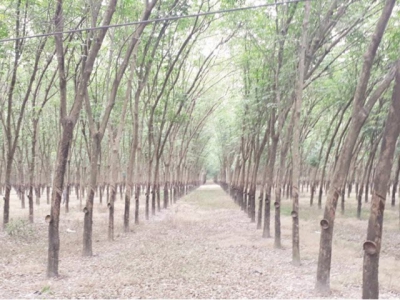New development for rubber industry

In recent years, rubber export price has decreased. In many areas, people have replaced rubber trees by growing other crops. To remove difficulties for the rubber industry, it needs to promote restructuring, improve quality and diversify product structure as well as markets.
According to the plan, by 2020, the area of rubber will reach 800,000 hectares. However, the area was 965,000 hectares in 2018.
Depending on Chinese market
According to a report from the MARD's Agricultural Products Processing and Market Development Department, volume and value of rubber exports in the first 11 months are estimated at 1.53 million tonnes and US$2.06 billion, up 9.9 percent in volume and 9.3 percent in value compared to 2018. China, India and South Korea were the three largest rubber consuming markets of Vietnam in the first 10 months of the year, accounting for 65.3 percent, 8.8 percent and 3 percent of market share respectively. In recent years, average export rubber price in the first 10 months reached US$1,353/tonne, down 1.1 percent compared to 2018.
The MARD said Vietnam has the world's third largest rubber output; however, 80 percent of natural rubber is exported as raw rubber. Processing technology is limited compared to other countries in the region and has not yet supplied raw materials for the domestic rubber industry. Notably, China is Vietnam's largest natural rubber import market, consuming more than 65 percent of Vietnam's total natural rubber exports and tending to increase.
Cao Duc Phat, Deputy Head of the Central Economic Commission said after more than 100 years of development, the rubber industry has played an important role in Vietnam's agriculture and forestry industry and is an agricultural product with large export value that brings a significant source of foreign currencies. However, Vietnam’s rubber industry has faced difficulties and challenges. Typically, rubber area increases rapidly, some areas are unplanned, unsuitable and have difficult natural and socio-economic conditions such as unfavourable natural conditions. In addition, rubber prices on the world market in 2015-2019 sharply fell. Vietnam's processed rubber products are mainly raw materials and heavily depend on the Chinese market.
Tran Ngoc Thuan, Chairman of the Vietnam Rubber Association said Vietnam has high rubber production and leading productivity in the world but the market and product strategy are completely passive. When the situation is difficult, some countries with large natural rubber production such as Malaysia, Thailand, Indonesia, and China issued flexible supportive policies, while Vietnam only issued general and unspecific policies.
Improve quality and change product structure
According to Thuan, with the current situation, the rubber industry needs to promote restructuring. In particular, the Government needs to have plans and issue development policies. Ministries and sectors need to boost the development of Vietnam's rubber industry, besides internal development of enterprises.
Deputy Minister of MARD Le Quoc Doanh said the solution is to transform rubber areas not suitable for development conditions in sub-regions or low quality and productivity into other more efficient crops; focusing on intensive farming to increase the productivity of rubber trees; striving to increase average rubber output from 3-4 percent/year; invest in upgrading processing facilities to change structure of rubber materials to meet consumption demands of the export market and the domestic rubber industry.
“Rubber companies need to diversify the market, reduce price and improve product quality to increase competitiveness. Domestic rubber raw material manufacturers need to change the structure, category and quality of rubber products to suit the demand of the domestic rubber industry,” Doanh said.
To remove difficulties for the rubber industry, Huynh Van Bao, General Director of Vietnam Rubber Group, suggested maintaining the rubber development plan under Decision 750/QD-TTg on rubber development plan by 2020, and reducing rubber area in arrears with favourable conditions to other crops with higher efficiency and developing industrial parks to the demand on industrial and service development in localities.
Regarding the accounting of selling rubber wood, Bao proposed that group's member companies be allowed to be accounted revenues from the sale of rubber wood after harvesting rubber latex which is just a common product (forestry products) and enjoyed tax incentives as rubber products (if any).
According to the Ministry of Agriculture and Rural Development, from 2011 to 2018, the country's rubber area increased sharply from 801,600 hectares in 2011 to 965,000 hectares in 2018. According to a plan approved by the Prime Minister, the rubber area has exceeded 165,000 hectares.
Currently, smallholder rubber plantation area accounts for 53.2 percent of total area with more than 265,000 households planting rubber. Planting and harvesting rubber in small scale, lack of linkage, techniques, and it is difficult to control all stages in the planting process, the quality is unstable, affecting the production market. The price of small-scale rubber material is lower from VND 1-1.5 million/tonne than the price of large-scale rubber due to its inferior quality and through many intermediary stages. In the context of low rubber prices, people began to plant other crops that are more effective and profitable than rubber trees.
Có thể bạn quan tâm
Phần mềm

Phối trộn thức ăn chăn nuôi

Pha dung dịch thủy canh

Định mức cho tôm ăn

Phối trộn phân bón NPK

Xác định tỷ lệ tôm sống

Chuyển đổi đơn vị phân bón

Xác định công suất sục khí

Chuyển đổi đơn vị tôm

Tính diện tích nhà kính

Tính thể tích ao hồ



 Vietnam to export fresh lychee to Japan after…
Vietnam to export fresh lychee to Japan after…  Rubber exports bounce back
Rubber exports bounce back